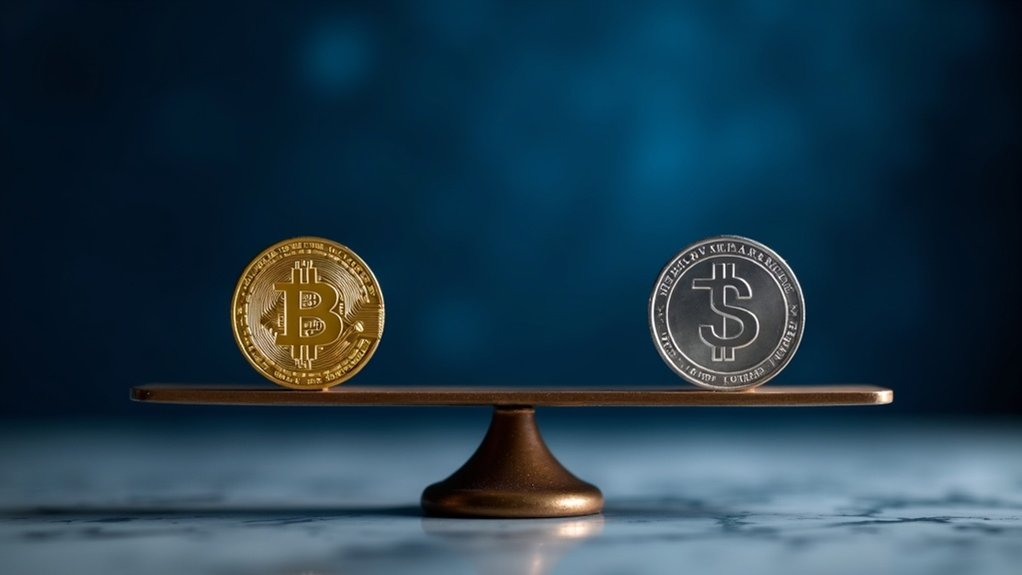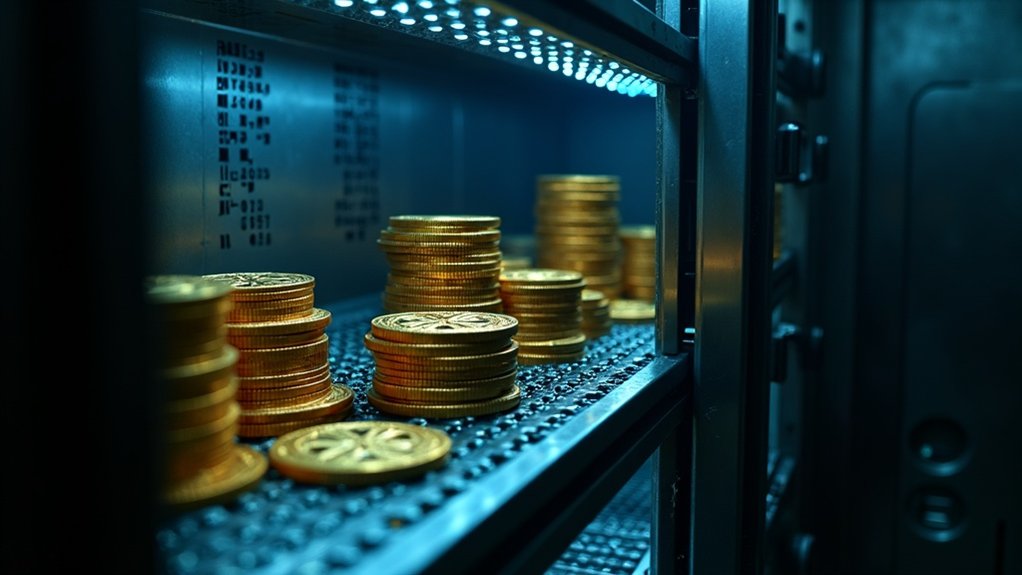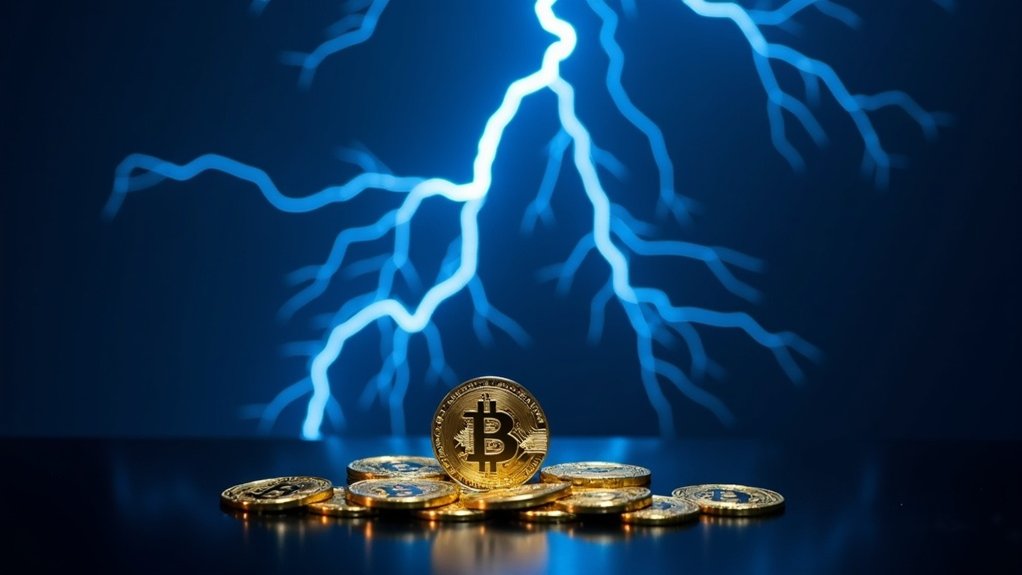Stablecoins are cryptocurrencies designed to maintain steady value by pegging to assets like the US dollar or gold. Unlike Bitcoin’s wild rollercoaster, these boring crypto cousins provide stability for everyday transactions. They come in different flavors: fiat-backed (with actual dollars in reserve), commodity-backed, crypto-collateralized, and algorithmic (using smart contracts). Traders use them as parking spots during market chaos, while merchants appreciate not having coffee prices change mid-sip. The $230 billion stablecoin market isn’t going anywhere.
Why do cryptocurrencies like Bitcoin feel like a rollercoaster ride? Simple. Their prices swing wildly, making them exciting investments but terrible currencies. Enter stablecoins—the sensible cousins in the crypto family.
Stablecoins are cryptocurrencies designed to maintain stable value by pegging themselves to assets like the US dollar, gold, or other stable commodities. No drama, no midnight price crashes, just boring stability. And in the financial world, boring can be beautiful.
They solve a fundamental problem. How can you use something as everyday money when its value might drop 20% before your coffee gets cold? You can’t. That’s why stablecoins matter.
Imagine paying for lunch with a currency that could buy dinner or just an appetizer by dinner time. That’s why stablecoins exist.
Most stablecoins maintain their peg through collateral. Fiat-collateralized versions like Tether (USDT) and USD Coin (USDC) supposedly keep real dollars in reserve for each token issued. Supposedly. The crypto world isn’t exactly known for transparency.
Other varieties exist too. Commodity-backed stablecoins link to gold or precious metals.
Crypto-collateralized versions use other cryptocurrencies as backing, often over-collateralized to account for volatility. Then there are the algorithmic ones—no physical backing, just math and hope. Those have worked out great. Just kidding. These tokens rely on smart contract systems to automatically adjust their supply and maintain stability.
Despite the “stable” in their name, these coins can still break their peg. When markets panic or backing reserves prove insufficient, even stablecoins can wobble. Just ask anyone holding Terra USD when it collapsed.
Stablecoins serve practical purposes beyond just avoiding volatility. They facilitate cross-border payments without traditional banking delays.
They provide a parking spot during market turbulence. Traders use them to quickly move between positions without converting back to fiat.
Governments are taking notice too. Regulatory frameworks are emerging worldwide to monitor these pseudo-dollars. Makes sense—when something acts like money but isn’t quite money, financial watchdogs get curious. These regulatory efforts focus on ensuring investor protection while addressing potential systemic risks as the market continues to expand.
The stablecoin market has expanded dramatically, with the global market size reaching approximately $230 billion by mid-2025, showcasing their growing importance in the cryptocurrency ecosystem.
The bottom line? Stablecoins bridge the gap between crypto’s wild frontier and the stable world of traditional finance. Not exciting, but extremely useful.
Frequently Asked Questions
How Are Stablecoins Regulated Globally?
Stablecoin regulation is a global patchwork of approaches.
The US has the GENIUS Act. Europe’s got MiCA with its ARTs and EMTs framework. Hong Kong just passed its Stablecoins Ordinance. Countries like Switzerland and Japan were early movers.
Regulators worry about everything—monetary sovereignty, peg stability, transparency.
They’re obsessed with consumer protection and preventing financial meltdowns.
Cross-border compliance? A nightmare. The rules are everywhere, but consistency? Not so much.
Can Stablecoins Be Used for Cross-Border Remittances?
Stablecoins are already reshaping cross-border remittances. They account for roughly 23% of global remittance flows, up from 16% in 2022.
Why? Simple economics. Traditional remittance corridors charge 6-8% fees. Stablecoins slash that dramatically.
In Asia alone, stablecoin remittances could exceed $250 billion by 2028. Platforms in the Philippines allow instant conversion to local currency.
India’s diaspora uses them to bypass delays, cutting fees below 3%.
The future’s arrived.
What Happens if a Stablecoin Issuer Goes Bankrupt?
If a stablecoin issuer goes bankrupt, holders now get super-priority status thanks to the GENIUS Act. They jump to the front of the creditor line, with claims against both reserves and other assets.
The automatic stay applies, but holders can seek relief within 14 days.
Pretty sweet deal for them.
For issuers though? Total nightmare.
They can’t use reserves for legal fees or financing, making reorganization nearly impossible.
Most will likely liquidate instead of attempting Chapter 11.
Bankruptcy law’s new frontier, folks.
How Do Stablecoins Impact Traditional Banking Systems?
Stablecoins shake up traditional banking in several ways. They enable faster, cheaper transactions 24/7 without those pesky intermediaries.
Banks face a double-edged sword: efficiency gains versus potential deposit drainage. If people switch to stablecoins, banks lose their sweet deposit funding.
Regulatory concerns? Plenty. Money laundering risks increase with pseudonymous transactions.
Still, smart banks are jumping in—offering stablecoin services could open new revenue streams. The banking dinosaurs must adapt or face extinction.
Are Stablecoins Environmentally Friendly Compared to Other Cryptocurrencies?
Stablecoins are dramatically more eco-friendly than their crypto cousins.
The numbers don’t lie.
While Bitcoin guzzles electricity through energy-intensive Proof-of-Work mining (think: small country’s worth of power), most stablecoins operate on Proof-of-Stake or centralized systems.
No mining means drastically lower carbon footprints.
Ethereum’s 99% energy reduction after switching to PoS says it all.
Stablecoins aren’t perfect—they still need computers and servers—but compared to Bitcoin? They’re practically tree-huggers.









